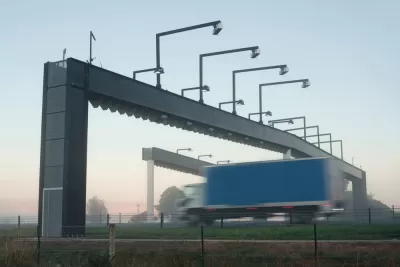Texas 130 has failed to live up to its revenue potential, leaving the private company that operates the road in junk bond status.

Katherine Blunt takes a deep dive in the revenue challenges facing SH 130 Concession Co., the private operator of the Texas 130 toll road.
According to Blunt, the company "hasn’t been able to shake the junk-bond rating Moody’s Investment Services assigned it two years ago because traffic counts on its sections have consistently failed to meet projections." Specifically, "Last year, traffic and revenue fell nearly 70 percent below the company’s original forecast, according to the ratings agency."
The article notes that traffic and revenue have been increasing slightly for several years, but not in enough quantity to rescue the company from its junk bond rating.
Blunt goes on to closely examine the toll road's shortcomings—in erms of its ability to attract the traffic necessary to make ends meet. Speaking of making ends meet, representatives from SH 130 Concession Co. blame a lack of "direct connectors" for the sluggish traffic levels. Blunt provides more context for how the road came into existence:
"TxDOT planned Texas 130 to relieve congestion between San Antonio and Austin on Interstate 35, a highway strained by population growth and cross-border trade. The department completed part of the road by 2006, but it didn’t have enough funding to build south of Mustang Ridge."
As for a more heavily travelled future for the toll road, the desired connector roads are still distant spots on the planning horizon:
"The Alamo Area Metropolitan Planning Organization has discussed the possibility of building a connector between I-35 and Texas 130 to makes the toll road more accessible from San Antonio. But City Councilman Ray Lopez, chairman of the MPO, said that project will likely take a back seat to other priorities in the area."
FULL STORY: Sparse traffic challenges Texas toll company

Study: Maui’s Plan to Convert Vacation Rentals to Long-Term Housing Could Cause Nearly $1 Billion Economic Loss
The plan would reduce visitor accommodation by 25,% resulting in 1,900 jobs lost.

North Texas Transit Leaders Tout Benefits of TOD for Growing Region
At a summit focused on transit-oriented development, policymakers discussed how North Texas’ expanded light rail system can serve as a tool for economic growth.

Why Should We Subsidize Public Transportation?
Many public transit agencies face financial stress due to rising costs, declining fare revenue, and declining subsidies. Transit advocates must provide a strong business case for increasing public transit funding.

How to Make US Trains Faster
Changes to boarding platforms and a switch to electric trains could improve U.S. passenger rail service without the added cost of high-speed rail.

Columbia’s Revitalized ‘Loop’ Is a Hub for Local Entrepreneurs
A focus on small businesses is helping a commercial corridor in Columbia, Missouri thrive.

Invasive Insect Threatens Minnesota’s Ash Forests
The Emerald Ash Borer is a rapidly spreading invasive pest threatening Minnesota’s ash trees, and homeowners are encouraged to plant diverse replacement species, avoid moving ash firewood, and monitor for signs of infestation.
Urban Design for Planners 1: Software Tools
This six-course series explores essential urban design concepts using open source software and equips planners with the tools they need to participate fully in the urban design process.
Planning for Universal Design
Learn the tools for implementing Universal Design in planning regulations.
City of Santa Clarita
Ascent Environmental
Institute for Housing and Urban Development Studies (IHS)
City of Grandview
Harvard GSD Executive Education
Toledo-Lucas County Plan Commissions
Salt Lake City
NYU Wagner Graduate School of Public Service



























